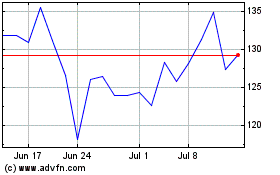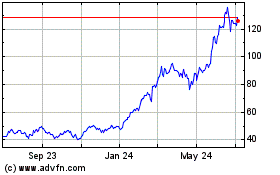Nvidia Unveils Massive Chip to Target 'Machine Learning'
April 05 2016 - 9:10PM
Dow Jones News
SAN JOSE, Calif.—Nvidia Corp. is stepping up plans to expand
beyond computer graphics into the field of artificial intelligence,
unveiling an unusual processor for the purpose and a computer that
uses it to solve scientific problems at extremely high speed.
The company on Tuesday said the new Tesla P100 chip, designed
for use in corporate data centers, achieves very high performance
by packing 15 billion transistors on a piece of silicon. That is
roughly twice as many as Nvidia's prior high-end graphics processor
and some new server chips Intel Corp. announced last week.
"It's the largest chip that has ever been made," said Jen-Hsun
Huang, Nvidia's chief executive, during a speech kicking off the
company's annual technology conference here.
He predicted the chip would initially be purchased by
unidentified cloud computing services and next year would begin
arrive in servers sold by other companies. Meanwhile, Nvidia plans
to offer its own $129,000 computer that comes with eight Tesla P100
chips and software for artificial intelligence applications.
Mr. Huang said the DGX-1, as the new computer is called, can
process artificial intelligence tasks as rapidly as 250 servers
powered by general-purpose chips like Intel's—an installation that
would cost much more. A typical chore that would take 150 hours on
one standard server, Mr. Huang said, would take two hours on the
DGX-1.
Nvidia, based in Santa Clara, Calif., has been on a multiyear
crusade to find users beyond videogames for the chips called GPUs,
for graphics processing units. The chips, which feature hundreds of
simple processors—compared with between one and 22 large
calculating engines found on a typical microprocessor—are already
used to solve scientific problems in many large supercomputers.
Mr. Huang recently has focused on artificial intelligence,
especially a technique called machine learning that is useful for
recognizing images and spoken language. Where conventional
image-recognition requires programmers to explicitly define the
characteristics of a face, machine-learning software enables
computers to learn to pick out faces by surveying huge quantities
of so-called training photos.
Nvidia already sells GPUs and special-purpose computers that use
machine learning to help cars map their surroundings, detect
hazards and drive on their own. Among other announcements at the
event Tuesday, the company said its hardware would be used by
entrants in an event called Roborace that is designed to test
autonomous sports cars.
Mr. Huang said Massachusetts General Hospital would be one of
the first customers for its DGX-1 system, which will help analyze
around 10 billion medical images to help study disease and devise
new treatments.
Companies are trying other kinds of chips to accelerate
machine-learning jobs. International Business Machines Corp., for
example, in 2014 announced a chip designed to function more like
the human brain than other processors.
Patrick Moorhead, an analyst at Moor Insights & Strategy,
noted that other companies are coming up with original chip designs
or using chips that can be electrically configured after they leave
the factory. But he said Nvidia is likely to have an impact on
fields where speed is important.
"This means instead of waiting for a day to train the system,
you could do that in hours," he said.
Nvidia is also betting heavily on virtual reality to drive
demand for GPUs. Mr. Huang on Tuesday demonstrated a new technology
called Iray that uses hardware in data centers to help generate 3-D
landscapes than look much more like photographic imagery than
today's VR systems.
Write to Don Clark at don.clark@wsj.com
(END) Dow Jones Newswires
April 05, 2016 20:55 ET (00:55 GMT)
Copyright (c) 2016 Dow Jones & Company, Inc.
NVIDIA (NASDAQ:NVDA)
Historical Stock Chart
From Mar 2024 to Apr 2024

NVIDIA (NASDAQ:NVDA)
Historical Stock Chart
From Apr 2023 to Apr 2024
